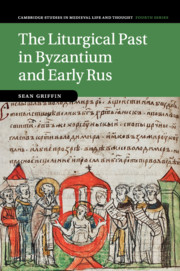Book contents
- The Liturgical Past in Byzantium and Early Rus
- Cambridge Studies in Medieval Life and Thought Fourth Series
- The Liturgical Past in Byzantium and Early Rus
- Copyright page
- Contents
- Acknowledgements
- Abbreviations
- Introduction
- Chapter 1 Liturgy and History in Early Rus
- Chapter 2 The Rus Primary Chronicle
- Chapter 3 Vespers at the Kiev Monastery of the Caves
- Chapter 4 The Dayspring Before the Sun:
- Chapter 5 A New Constantine in the North:
- Chapter 6 A RATIONAL SACRIFICE:
- Conclusion:
- Bibliography
- Index
Introduction
Published online by Cambridge University Press: 09 August 2019
- The Liturgical Past in Byzantium and Early Rus
- Cambridge Studies in Medieval Life and Thought Fourth Series
- The Liturgical Past in Byzantium and Early Rus
- Copyright page
- Contents
- Acknowledgements
- Abbreviations
- Introduction
- Chapter 1 Liturgy and History in Early Rus
- Chapter 2 The Rus Primary Chronicle
- Chapter 3 Vespers at the Kiev Monastery of the Caves
- Chapter 4 The Dayspring Before the Sun:
- Chapter 5 A New Constantine in the North:
- Chapter 6 A RATIONAL SACRIFICE:
- Conclusion:
- Bibliography
- Index
Summary
The book opens with two historical scenes, separated in time by nearly a thousand years. In the first, Vladimir Putin makes a speech in front of a new sixty-foot monument of Saint Vladimir the Great, the baptizer of Rus. Looking into the television camera, the president retells the myth of Christian origins of Russian civilization—a sacred story that was first written down in the early twelfth century by the clerical authors of the Rus Primary Chronicle (Повесть временных лет). In the second scene, readers are transported to eleventh-century Constantinople, where the Byzantine emperor and the patriarch are celebrating the Feast of Saints Constantine and Helena. They lead a liturgical procession of thousands across the city, and along the route the clergy ritually retell the story of the conversion of the Roman Empire. There follows a brief narrative history of how Byzantine church books were translated and transported into late tenth-century Kiev. The chapter concludes with the principal argument of the book: that the myth of Saint Vladimir and his kin recorded in the Rus Primary Chronicle has its source in the liturgical services of the Byzantine Empire.
Keywords
- Type
- Chapter
- Information
- The Liturgical Past in Byzantium and Early Rus , pp. 1 - 14Publisher: Cambridge University PressPrint publication year: 2019

